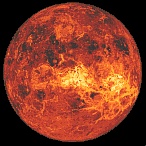 Venus is the second planet from the Sun. Its orbit is said to be "inferior" as it lies between the Sun and the Earth. Venus always appears in the sky comparatively near to the Sun, being visible a little before sunrise or a little after sunset. Venus is the second planet from the Sun. Its orbit is said to be "inferior" as it lies between the Sun and the Earth. Venus always appears in the sky comparatively near to the Sun, being visible a little before sunrise or a little after sunset.
The planet's atmosphere is composed mainly of carbon dioxide, (CO2) amounting to 97% of the total mass. The CO2 causes a massive greenhouse effect, raising the surface temperature as high as 490°C, hotter than Mercury!
Slow Mover
The planet rotates once every 243 Earth days, yet clouds have been observed to rotate once every four days indicating winds of 100m/s. Furthermore, its orbit takes only 225 days! These clouds extend to 70km above the planet's surface, and hide all of the surface from telescopes on Earth. They are largely composed of sulphuric acid (H2SO4), and make conditions at the surface highly corrosive.

© 2003 Don P. Mitchell. Used with permission.
The Soviet Union launched a number of Venera series probes to return information from Venus, the first in 1961. Most of the early probes failed for various reasons, not in the least because of the hostile conditions found on the planet's surface. It wasn't until 1975 that the first pictures were returned by Veneras 9 and 10. Venera 14 captured the picture above of its landing site in 1982. The colour chart (lower right) show how gray, red, green and blue appear under the orange light from the sky.
 Atlas of Venus Atlas of Venus
Patrick Moore and Peter Cattermole bring amateur astronomers an enjoyable Atlas of Venus, one of the most up-to-date books available on the geography and geology of this remarkable planet. Order yours today. (UK | US).
 Venus Express Venus Express
In 2005, ESA launched Venus Express, a probe similar to Mars Express, but with a different destination!
On its way now, Venus Express should help us understand why Venus and Earth are so radically different. It will study its atmosphere in new ways, and carry out the first RADAR sounding of its surface layers.
Top Right ^^

View | Sign Guestbook
|
Venus Transit 2004
About once or twice a century, Venus passes directly in front of the Sun, as viewed from the Earth (much like the Moon during a Solar Eclipse).  This previously happened in 1874, 1882 and 2004, and will next occur in 2012. This previously happened in 1874, 1882 and 2004, and will next occur in 2012.
The great Edmund Halley never saw a transit, but recognised their importance in measuring the size of the solar system. Through his work, explorers including Captain Cook were to make observations of transits in 1761 and 1769, after Halley's death. More on Halley.
 Patrick Moore and Michael Maunder outline their fascinating history in TRANSIT. Humans travelled all over the world to see them take place. Today it is possible for amateur astronomers today to observe transits of all kinds - even modern occurences, such as aircraft! Patrick Moore and Michael Maunder outline their fascinating history in TRANSIT. Humans travelled all over the world to see them take place. Today it is possible for amateur astronomers today to observe transits of all kinds - even modern occurences, such as aircraft!
Into Orbit
 On August 10th 1990, the NASA Magellan probe entered orbit - the first probe ever to become an artificial satellite of another planet. The surface of Venus is normally completely shrouded by the dense clouds. However, by using RADAR, Magellan was able to complete a very successful mission in October, 1994, having mapped 98% of its surface in highly intricate detail. The image on the right is from a mosaic of RADAR images, with a resolution 10× better than the earlier Soviet Venera missions. On August 10th 1990, the NASA Magellan probe entered orbit - the first probe ever to become an artificial satellite of another planet. The surface of Venus is normally completely shrouded by the dense clouds. However, by using RADAR, Magellan was able to complete a very successful mission in October, 1994, having mapped 98% of its surface in highly intricate detail. The image on the right is from a mosaic of RADAR images, with a resolution 10× better than the earlier Soviet Venera missions.
![[craters]](images/crat.jpeg) The RADAR used operated at a frequency of 2·385 GHz, peak power of 325W, and pulse length of 26·5 microsec. During its extended mission, completed in September 1992, two further mapping cycles brought coverage to 98%, showing detail of about 100m. The image on the right is a close-up view of some craters. Magellan allowed the first global geological understanding of Venus, the planet most like Earth in the Solar System. The RADAR used operated at a frequency of 2·385 GHz, peak power of 325W, and pulse length of 26·5 microsec. During its extended mission, completed in September 1992, two further mapping cycles brought coverage to 98%, showing detail of about 100m. The image on the right is a close-up view of some craters. Magellan allowed the first global geological understanding of Venus, the planet most like Earth in the Solar System.
Navigate:
Map of Venus | Mythical Icons
|




 This previously happened in 1874, 1882 and 2004, and will next occur in 2012.
This previously happened in 1874, 1882 and 2004, and will next occur in 2012.